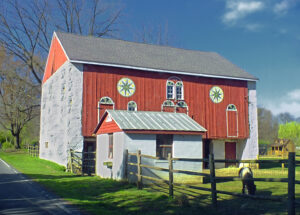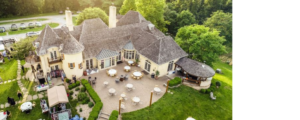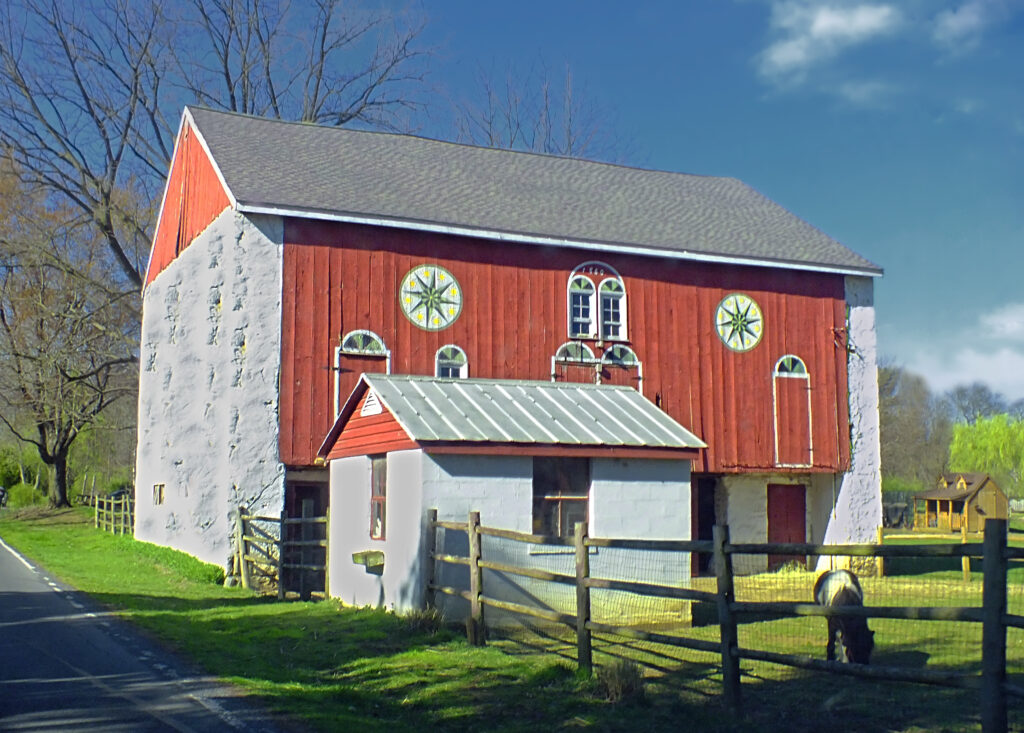
The Pennsylvania Dutch Country – the home of Bondelandet Lodge 3-612

Nicholas A. Tonelli from Pennsylvania, USA – Barn Style (2) CCBY2.0
Pennsylvania German–style barn, Maxatawny Township, Berks County.
Pennsylvania Dutch Country, sometimes called the Distelfink Country, is an area of Southeastern and South Central Pennsylvania that by the American Revolution had a high percentage of Pennsylvania Dutch inhabitants. Religiously, there was a large portion of Lutherans. There were also German Reformed, Moravian, Amish, Mennonite, Schwarzenau Brethren, and other German Christian sects. Catholics settled around early Jesuit missions in Conewago (near Hanover, PA) and Goshenhoppen (now called Bally, PA). The term was used in the middle of the 20th century as a description of a region with a distinctive Pennsylvania Dutch culture, but in recent decades the composition of the population is changing and the phrase is used more now in a tourism context than any other.
Greater Pennsylvania refers to this region as well as historically Pennsylvania Dutch-speaking areas of Maryland, North Carolina, and Virginia.
Geographically, the area referred to as Amish/Dutch country centers on the cities of Allentown, Hershey, Lancaster, Reading, and York. Pennsylvania Dutch Country encompasses the counties of Lancaster, York, Adams, Franklin, Dauphin, Cumberland, Lebanon, Berks, Northampton, Montgomery, Lehigh, Schuylkill, Snyder, Union, Juniata, Mifflin, Huntingdon, Northumberland, and Centre. Pennsylvania Dutch immigrants would spread from this area outwards outside the Pennsylvania borders between the mountains along river valleys into neighboring Maryland (Washington, Frederick, and Carroll counties), West Virginia, New Jersey (Warren and northern Hunterdon counties), Virginia (Shenandoah Valley), and North Carolina. The larger region has been historically referred to as Greater Pennsylvania. The historic Pennsylvania Dutch diaspora in Ontario, Canada has been referred to as Little Pennsylvania.
The area lies in the Piedmont region of the Appalachian mountains. The landscape is marked by rolling, wooded hills, deep stream valleys, and fertile soils. The Susquehanna River bisects the region and provides its drainage.
A small sample of “Things to do”
 Wine tasting never ends on the year-round Mason-Dixon Wine Trail®, so gather your friends and come visit us. Vineyards stretch from York County to Hershey, Gettysburg and Lancaster through Pennsylvania’s Dutch County Roads and south to the Mason-Dixon line.
Wine tasting never ends on the year-round Mason-Dixon Wine Trail®, so gather your friends and come visit us. Vineyards stretch from York County to Hershey, Gettysburg and Lancaster through Pennsylvania’s Dutch County Roads and south to the Mason-Dixon line.
Throughout the year, wineries offer festivals, concerts and special events. Combine your visit with a wallet-friendly package to make the perfect Sip & Stay Getaway.
As one of our Good Libations Trails®, you can find more information on the Mason-Dixon Wine Trail® in our Good Libations Trails® Map & Passport. Request your copy today!
If you want to keep up with all the exciting things going on along the Mason-Dixon Wine Trail®, sign up for our monthly e-newsletter, the Explore York Getaway Guide. Make sure to like our Explore York Facebook page to stay connected to all things York County!

Step back to 1915 when the railroad was at the center of village life. Costumed interpreters welcome you to the M.M. Grove General Store, mill and grain elevator. Motorcar trains offer a 5 mile trip through the scenic Muddy Creek Valley on the mail line of the famous Ma & Pa Railroad.
The Maryland and Pennsylvania Railroad was established in 1901 by the merging of the Baltimore and Lehigh Railway with the York Southern.
Originally a narrow gauge line, the railroad traced a meandering seventy-seven mile route to connect Baltimore and York, two cities only forty-five highway miles apart. The line’s surveyors could hardly have chosen a more picturesque route. The mainline traveled northeast from Baltimore across the rolling Maryland hills through Towson and Bel Air.
At Delta, Pa., the line turned sharply northwest, hugging the banks of Muddy Creek and passing through Felton, Red Lion, and Dallastown on its climb into York. Although traffic was never very dense, the Ma & Pa did serve as an indispensable link between rural communities and the outside world in the days before modern highways and two automobiles in every garage.
It hauled furniture from Red Lion, slate from Delta, and milk from farms along the route, fostering the economic progress of the whole region. The railroad also carried countless residents from their rural homes to the “big city” for jobs, shopping, and entertainment, despite the fact that its “crack” passenger train took four hours to travel seventy-seven miles.
The loss of a U.S. Mail contract and the encroachment of the automobile doomed passenger service, which succumbed in 1954.
The Maryland Division from Whiteford south was abandoned in 1958, but the Pennsylvania portion survived into the 80’s. At that time, the Society stepped in to preserve a piece of this unique little railroad, which was so prominent in the history and development of the area.

The William C. Goodridge Freedom Center and Underground Railroad Museum at 123 E. Philadelphia St. in York is the former Goodridge family home.
It is one of few African American culture sites nationwide.
Goodridge was an African American man who rose from enslavement to business prominence in 19th Century Pennsylvania. He owned numerous properties and operated multiple businesses, all while secretly transporting slaves to freedom via secret compartments he had constructed in his railroad cars.
During renovations in the 1890s, workers found a hideaway (believed to have been hand-dug for freedom seekers) under the kitchen of the home.
That hideaway and an intriguing collection of Goodridge-related artifacts are on display at the center and museum.
Crispus Attucks York has overseen the nonprofit center for about 20 years. In 2003, it became one of the first National Underground Railroad Network to Freedom sites designated by the National Park Service as a National Historic Landmark.
In July 2020, The William C. Goodridge Freedom Center and Underground Railroad Museum was proud to announce its membership with the International Coalition of Sites of Conscience, a worldwide network of Sites of Conscience that builds the capacity of vital institutions through grants, networking, training, transitional justice mechanisms and advocacy.
For more about the fascinating life of William C. Goodridge, click here. To learn more about Crispus Attucks York, click here.

Explore Gettysburg. The Museum & Visitor Center is the official start to your Gettysburg visit.
Begin your journey with the film presentation A New Birth of Freedom and set the framework for your visit. Experience the sights and sounds of Pickett’s Charge in the iconic Gettysburg Cyclorama. Explore the rare artifacts and interactive exhibits in the Gettysburg Museum of the American Civil War. Tour the battlefield and visit the legendary landmarks with a Licensed Battlefield Guide by motorcoach or enjoy a customized tour in your own vehicle. Connect to the battlefield and its stories through National Park Service programs.
Include our Exhibits, Tours & Events to make your Gettysburg visit truly historic. Step into history with visits to our historic sites. Unique opportunities and enlightening experiences await you.
For tickets, call 877-874-2478 or visit GettysburgFoundation.org.
